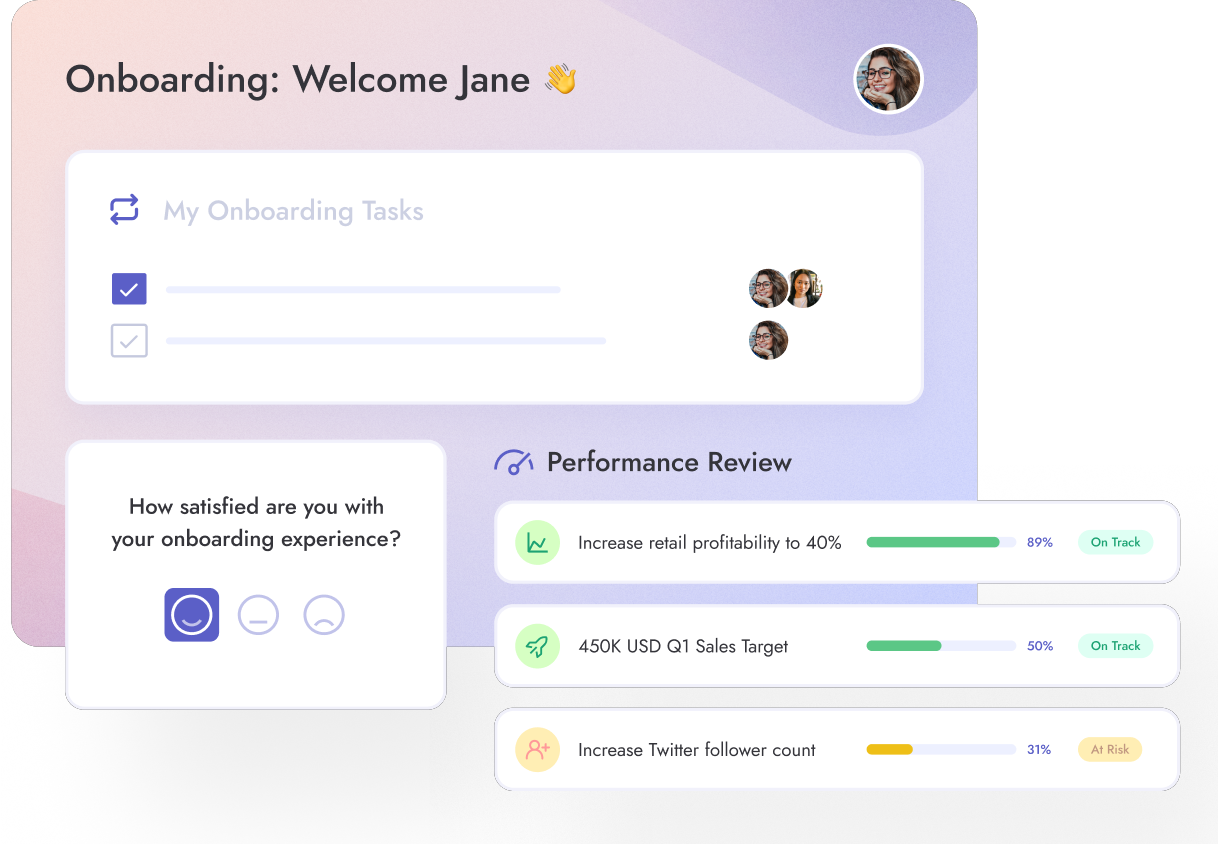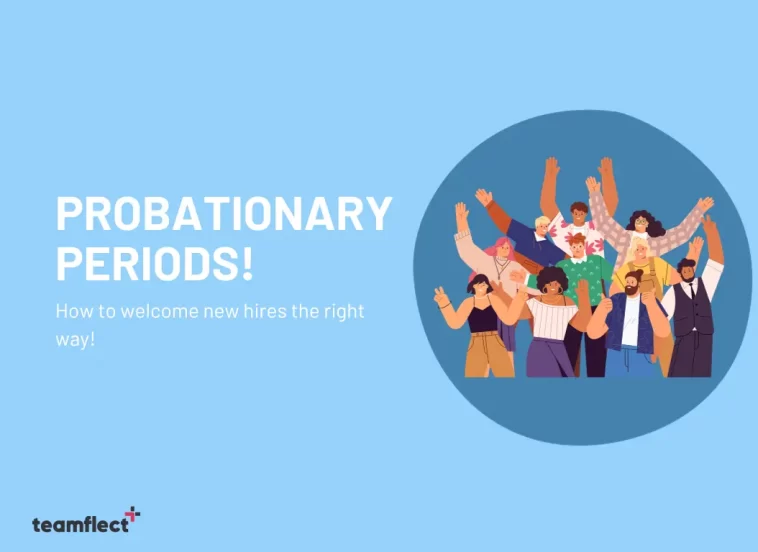If there is one piece of language we absolutely despise here in the Teamflect blog, it is the term “Probationary Period”. As we’ve touched upon in a previous article on probation reviews, the entire terminology is a bit hostile for our taste.
Who is on probation? Is it healthy to point out that someone is on thin ice from the very start? And most importantly; Why are we borrowing language from the criminal justice system in our workplace!?
In fact, we’ve discussed this very topic with one of the brightest minds in people and culture, Amy Brand on our podcast, The Team Check-in, where she explained how they completely revamped their probation periods over at CC
The optics of it aside, we know that a healthy probation period at work is an absolute must when onboarding new hires. That is why we put together this helpful guide on probationary periods, helping you with everything from probation period definitions to probation period best practices, and useful employee onboarding tools.
Let’s make those newcomers feel welcome!
Table of Contents
What is a probationary period?
is a defined timeframe during which an employee’s performance and suitability for a specific job role are closely monitored and assessed.
This period typically occurs at the beginning of employment, although it can also be implemented when an employee transitions to a new position or takes on new responsibilities within the organization.
During the probationary period, new employees are expected to demonstrate their abilities, adapt to the company culture, and meet established performance expectations.
It serves as a trial period for both the employer and the employee, allowing both parties to evaluate whether the working relationship is a good fit.
How long is an average probationary period?
If you’re asking the question “What is the best length for a probationary period?”, the answer depends on a bunch of different variables.
In most cases, probationary periods range from 30 to 90 days, but they can extend up to six months or even a year in specific industries or for specialized positions.
Some organizations may also implement a tiered probationary period, with shorter initial assessments followed by longer ones if needed.
Variables that can influence the length of probation periods:
Industry Standards
Different industries may have different norms for probationary periods. For example, in industries where training is extensive or job responsibilities are complex, a longer probationary period may be appropriate.
Job Complexity
The complexity of the job plays a huge role in how long a probation period may last. For roles that require a steep learning curve or involve intricate tasks, a longer probationary period may be necessary to allow for a comprehensive assessment of the employee’s capabilities.
Training Time
If the job requires substantial training, the probationary period should be long enough to ensure that the employee has had adequate time to learn and apply the necessary skills.
Company Culture
The culture of the organization also plays a role. Some companies may prefer a shorter probationary period to quickly assess fit, while others may opt for a more extended period to provide ample time for evaluation and adjustment.
What is the purpose of a probation period?
So, with all the controversy surrounding probation periods for new employees, the question then becomes: “Are probation periods necessary?”. We may not like the name but probation periods for new hires are definitely necessary.
Having a probation period protects both the organization and the new hires, presenting a healthy transition and onboarding period. If managed well, an employee probation period can serve multiple very important purposes.
1. Evaluation of Job Fit
One of the primary purposes of a probationary period is to assess whether the employee is a good fit for the job and the organization. It allows employers to determine if the employee possesses the skills, knowledge, and qualities required to excel in the role.
This goes both ways. A 90-day probation period also helps the new employee gauge whether this new organization is a good fit for them or not.
2. Reducing Risk
For employers, a probationary period helps mitigate the risk associated with hiring new personnel. If an employee’s performance does not meet expectations during this time, the company can terminate their employment with minimal legal complications.
3. Performance Improvement
On the employee’s side, the probationary period provides an opportunity to acclimate to the new role, receive feedback, and make necessary adjustments to improve their performance. It can be a crucial period for skill development and career growth.
Employee Probation Period Laws
While probation periods exist as a way to protect organizations and employees from the legal ramifications of a bad fit, there is still a legal side to be considered even during probationary periods. While there are no direct laws about probation periods in most cases, probation periods fall under the jurisdiction of most employment and labor laws around the world.
Before we begin, we just need to point out that what we are pointing out below is not legal advice and we are by no means acting as your lawyer. This is just for informational purposes.
1. Anti-Discrimination Laws
This should go without saying but we’ll just point it out anyway: Probationary periods do not exempt employers from adhering to anti-discrimination laws.
It is an absolute must that assessments during this period are based on job performance and merit rather than factors such as race, gender, age, or other protected characteristics. This exists along the same vein as many other performance review laws.
2. Employment Contracts
While we are all so used to accepting terms and conditions without so much as a glance it is an entirely different ballgame when it comes to employment contracts! If an employment contract is in place, it should clearly outline the terms and conditions of the probationary period.
It needs to ensure that both parties understand the expectations, including the duration and the criteria for successful completion.
3. Termination Laws
Even during a probationary period, termination procedures must comply with labor laws. Employers should be aware of notice requirements, severance pay regulations, and any other legal obligations associated with terminating an employee.
As is the case with most laws surrounding employment contracts, the legal side of probation periods truly depends on the contracts being signed. However, a probation period isn’t some magical duration of time that exempts one from all legal liabilities.
How to manage employees during a probationary period?
As is the case with most processes in performance management, the reason probation periods may not get the best rep is usually because they aren’t being managed properly. That is why we want to outline some best practices for managing probationary periods, as well as some common mistakes that should be avoided.
1. Roles. Responsibilities. Goals.
At the end of the day, a probation period is just a worse way to refer to an employee onboarding period. You can’t have a decent onboarding process without some effective preboarding.
The most important piece of preboarding you can do when it comes to new hire probation periods is defining roles responsibilities and goals clearly. Leave no room for ambiguity.
There are some incredible goal-setting and employee onboarding tools you can take advantage of in that regard. In fact, we will leave some helpful lists for you to look over right here:
That being said, the best way to go is to take advantage of a performance management software that combines takes care of all of it for you:
Teamflect: Best Onboarding Software for Microsoft Teams

As an all-in-one performance management solution for Microsoft Teams, Teamflect is the best platform for you to help your new hires feel welcome. It has all the features you need to make your probationary periods as effective as possible:
- Onboarding Tasks
- Continuous Feedback
- Onboarding Survey Templates
- 30-60-90 Day Review Templates
- Employee Recognition
- Goal & OKR Management
- Individual Development Plans
And more! You can try Teamflect inside Microsoft Teams for absolutely free and without signing up! Just click the button below:
2. Surveys. Praise. Feedback.
While the previous trifecta we highlighted were all about setting the stage properly, this next trio is all about keeping new hires engaged. During the first 30-60-90 days of a new hire’s employment, it is extremely important that you:
Implement a culture of continuous and 360-degree feedback
This not only helps you gain insight into the new hire’s performance but also helps you gauge just how welcoming your organization is to newcomers. You will not only see your new hire through the eyes of your veteran employees but you will also view your organization through a fresh set of eyes.
Conduct quick and simple pulse surveys
Utilizing pulse survey software, you can conduct clear and concise pulse surveys to measure employee engagement alongside various other metrics you choose to measure your new hires by.
Recognize accomplishments
It is never too early for employee praise or employee spotlights! If you are looking for way to keep your new hires engaged, you should definitely start including them in your employee recognition program. Praise your new hires often and praise them publicly to make sure they are always feeling welcome.
Common Mistakes Made During Probationary Periods
1. Failure To Set Clear Expectations
Unclear expectations can lead to misunderstandings, frustration, and potential performance issues. Employees may not know what is expected of them, making it challenging to meet standards.
2. Inadequate Training and Support:
Without proper training, employees may struggle to meet performance expectations. This lack of support can result in decreased morale and confidence.
3. A Lack Of Feedback:
Infrequent feedback leaves employees in the dark about their performance. Constructive feedback is crucial for improvement, and the absence of it can hinder the employee’s development.
4. Ignoring Early Warning Signs:
Addressing performance concerns promptly is crucial. Ignoring warning signs can lead to prolonged issues that may be more challenging to resolve later, and it increases the risk of termination.
5. Failure to Document Performance:
Without proper documentation, it’s challenging to conduct fair and objective performance reviews. This documentation is also essential in case termination becomes necessary.
A FREE Probation Review Template

At the end of each probationary period, you need to conduct an employee probation review. Now you can go with the traditional method of using Excel performance review templates but we recommend that you conduct your probation reviews using an integrated performance review solution.
Below, you will find a link to a 90-Day Review Template that you can integrate into Microsoft Teams. This way you can keep your entire onboarding / probationary period inside your communication and collaboration platform:




